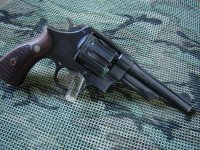I have a Heavy Duty that I fired for the first time today. The timing seems to be good, cylinder stop drops and locks in prior to hammer locking back. It has very little rotational and end play. While firing single action every now and then the hammer will not rotate the cylinder. The hammer just sticks and nothing happens. I open the cylinder and close it and it works again for a while and then it happens again. I tried dry firing with no problem and I tried putting spent cases in and can not duplicate.
Scrubbed ratchet star and cleaned ratchet and under it and did not see any problem. I was using UMC LRN, new Black Hills 148 wad cutters and Samson +P and all had the same problem so I don't think it's ammo related. It occurs intermittently. I have not had the side plate off yet. Any ideas as to why this happens?
BTW, I have not shot it after the cleaning.
Scrubbed ratchet star and cleaned ratchet and under it and did not see any problem. I was using UMC LRN, new Black Hills 148 wad cutters and Samson +P and all had the same problem so I don't think it's ammo related. It occurs intermittently. I have not had the side plate off yet. Any ideas as to why this happens?
BTW, I have not shot it after the cleaning.

